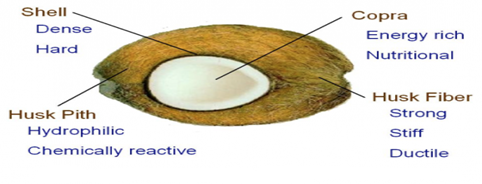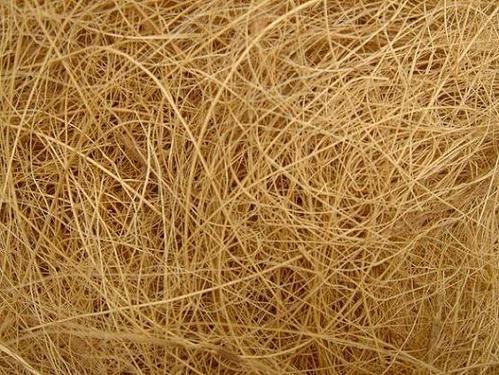Now You Know An Overview of Coconut / Coir Fiber
Sunday, 3 February 2019
Edit
An Overview of Coconut / Coir Fiber
Huzaifa Wazir
B.Sc. Textile Engineering
National Textile University, Faisalabad, Pakistan
Email: huzifawazir@gmail.com
Contact: +92-3040575377
B.Sc. Textile Engineering
National Textile University, Faisalabad, Pakistan
Email: huzifawazir@gmail.com
Contact: +92-3040575377
Introduction:
Coconut fiber is one of the natural fibers abundantly available in tropical regions, and is extracted from the husk of coconut fruit. Coconut fiber is extracted from the outer shell of a coconut. Respectively. According to official website of International Year for Natural Fibers 2009, approximately, 500 000 tonnes of coconut fibers are produced annually worldwide, mainly in India and Sri Lanka. Its total value is estimated at $100 million. India and Sri Lanka is also the main Exporters, followed by Thailand, Vietnam, the Philippines and Indonesia. Around half of the coconut fibers produced is exported in the form of raw fiber.
 |
| Coconut fiber |
Cross sectional & longitudinal view:
 |
| Cross sectional & longitudinal view of coir fiber |
 |
| Structure of coir fiber |
 |
| Parts of coconut |
There are generally two types of coconut fiber. These types are categorized on the basis of age.
1. Brown fiber: Brown fibres are extracted from matured coconuts. Brown fibers are thick, strong and have high abrasion resistance.
 |
| Brown fiber |
 |
| White fiber |
Coconut fibers are commercial available in three forms.
- Bristle fiber: These are long fibers.
- Mattress fiber: These are relatively short fibers.
- Decorticated fibers: These are mixed fibers.
Harvesting and husking:
Coconuts that have ripened and fallen from the tree may simply be picked up off. The outer layers covering the coconut seed are processed and spun into fibers commonly known as coir.
The ground. Coconuts still clinging to the 40-100 ft (12-30 m) tall trees are harvested by human climbers. If the climber picks the fruit by hand, he can harvest fruits from about 25 trees in a day. If the climber uses a bamboo pole with a knife attached to the end to reach through the treetop vegetation and cut selected coconuts loose, he can harvest 250 trees per day. (A third harvesting technique, in which trained monkeys climb trees to pick ripe coconuts, is used only in countries that produce little commercial coir.)
 |
| Manufacturing Process of Coir Fiber |
Retting:
Retting is a curing process during which the husks are kept in an environment that encourages the action of naturally occurring microbes. This action partially decomposes the husk's pulp, allowing it to be separated into coir fibers and a residue called coir pith. Freshwater retting is used for fully ripe coconut husks, and saltwater retting is used for green husks.
- For freshwater retting, ripe husks are buried in pits dug along riverbanks, immersed in water-filled concrete tanks, or suspended by nets in a river and weighted to keep them submerged. The husks typically soak at least six months.
- For saltwater retting, green husks are soaked in seawater or artificially salinated fresh water. Often this is accomplished by placing them in pits along riverbanks near the ocean, where tidal action alternately covers them with sea water and rinses them with river water. Saltwater retting usually takes eight to 10 months, although adding the proper bacteria to the water can shorten the retting period to a few days.
- Mechanical techniques have recently been developed to hasten or eliminate retting. Ripe husks can be processed in crushing machines after being retted for only seven to 10 days. Immature husks can be dry milled without any retting. After passing through the crushing machine, these green husks need only be dampened with water or soaked one to two days before proceeding to the defibering step. Dry milling produces only mattress fiber.
- Traditionally, workers beat the retted pulp with wooden mallets to separate the fibers from the pith and the outer skin. In recent years, motorized machines have been developed with flat beater arms operating inside steel drums. Separation of the bristle fibers is accomplished by hand or in a machine consisting of a rotating drum fitted with steel spikes.
- Separation of the mattress fibers from the pith is completed by washing the residue from the defibering process and combing through it by hand or tumbling it in a perforated drum or sieve. (Saltwater retting produces only mattress fibers.)
- The clean fibers are spread loosely on the ground to dry in the sun.
- Bristle fibers that will not immediately be further processed are rolled and tied into loose bundles for storage or shipment. More mechanized producers may use a hydraulic press to create compact bales.
- Similarly, mattress fibers may simply be baled with a hydraulic press. However, if more processing is desired, the fibers are combed with mechanical or manual carding tools, then loosely twisted into a thick yarn (wick), and wound into bundles. Later, the wick can be re-spun into a finer yarn. Techniques vary from simple hand spinning to use of a hand-operated spinning wheel or a fully automated spinning machine.
- Depending on its intended final use, the yarn may be shipped to customers, or multiple strands may be twisted into twine and bundled for shipment. Both traditional manual techniques and newer mechanical methods are used to braid twine into rope and to weave yarn into mats or nets.
- For some uses, such as upholstery padding, bristle fiber is loosely spun into yarn and allowed to rest. Then the fibers, which have become curly, are separated. These fibers are lightly felted into mats that are sprayed with latex rubber, dried, and vulcanized (heat treated with sulpher).
- Lignin……………..............……………….45.84%
- Cellulose………….............……………….43.44%
- Hemi-Cellulose……………......................00.25%
- Pectin’s and related Compound………….03.00%
- Water soluble…………….........................05.25%
- Ash……………………..............................02.22%
- Length in inches………………..6-8
- Density (g/cc)………………….1.40
- Tenacity (g/Tex)……………….10.0
- Breaking elongation%....................30%
- Diameter in mm…………………..0.1 to 1.5
- Rigidity of Modulus………………1.8924 dyne/cm2
- Swelling in water (diameter)…………5%
- Moisture at 65% RH……………….10.50%
Fiber fineness: The fiber fineness varies between 50 and 300µm.
Effects of acids: The exceptionally high lignin content implies that the available dyeing and bleaching techniques for textile fibers cannot simply be transferred to coir.
End uses of coir fiber:
- White coir spun into yarn is used in the manufacture of rope.
- Brown coir is used in preparation of carpets.
- Brown coir is also used In formation of door mates.
- Brown coir is also used in manufacturing of mattresses.
- Coir fiber is also used in auto mobiles.
- Geotextiles made from coir mesh (at left) are durable, absorb water, resist sunlight, facilitate seed germination, and are 100% biodegradable.
- Coir peat, a residue of milling, is gaining economic importance as mulch, soil treatment and a hydroponic growth medium.
- Coir Fiber Liners that are environment friendly products and are used for indoor gardening. These products offer an outstanding drainage and aeration to roots and prevent the plant from root rot.
- Coir fiber is also used in home decoration pieces.
- It is also used in making idols.
- It is also used in making sofas.
- Coir fiber bricks are used for many purposes.
- Coir fiber is used making toys.
- It is also used in making brushes.
- Coir fiber is also used in cosmetics.